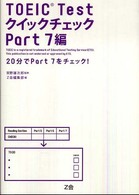- ホーム
- > 洋書
- > 英文書
- > Business / Economics
Full Description
Wastewater Engineering: Issues, Trends, and Solutions explains current treatment scenarios of wastewater in different countries across the globe, the characteristics of wastewater, and rules and regulations associated with the treatment and disposal/reuse of wastewater. It covers the design and theory involving laying of sewerage network and different conventional and advanced treatment technologies employed to treat domestic wastewater. It overviews different types of emerging contaminants and their properties, ecological impacts, detection/quantification, treatment technologies, and circular economy.
Features:
Gives an overview of current wastewater treatment scenarios across the world
Provides insights into emerging contaminants sources, procedure to sample, available methods for analyses, and possible treatments
Reviews existing rules and regulations on wastewater engineering and standards for wastewater disposal or reuse
Includes how to use wastewater as a resource in the context of circular economy
Describes fundamentals of wastewater conveyance and treatment
The book is aimed at graduate students and researchers in wastewater treatment, water, and environmental engineering.
Contents
1. Overview of Wastewater Management 1.1. Background 1.2. Need for Wastewater Management 1.3. Challenges in Wastewater Management 1.4. Current Wastewater Management Scenario 1.5. Approaches to Sustainable Wastewater Management 1.6. Overview of Processes Involved in a Typical Sewage Treatment Plant 1.7. Chapter Summary 1.8. Concluding Remarks 2. Wastewater: Sources, Characterization, and Analysis 2.1. Introduction 2.2. Components of Sewage 2.3. Characteristics of Sewage 2.4. Important Parameters of Wastewater and Their Analysis 2.5. Chapter Summary 2.6. Concluding Remarks 3. Legal Aspects of Municipal Wastewater Management and Standards 3.1. Introduction 3.2. Existing Legislative Mandates for Wastewater Management across the World 3.3. Wastewater Discharge Standards 3.4. Wastewater Reuse Standards 3.5. Sludge Disposal Regulations 3.6. Chapter Summary 3.7. Concluding Remarks 4. Wastewater Treatment System 4.1. Introduction 4.2. Types of Treatment Systems 4.3. Sewerage System 4.4. Chapter Summary 4.5. Concluding Remarks 5. Overview of Conventional Wastewater Treatment Processes: Primary Treatment 5.1. Introduction 5.2. Screening 5.3. Grit Removal 5.4. Sedimentation 5.5. Chapter Summary 5.6. Concluding Remarks 6. Overview of Conventional Wastewater Treatment Processes: Secondary Treatment 6.1. Introduction 6.2. Aerobic Treatment Process 6.3. Anaerobic Wastewater Treatment 6.4. Secondary Settling 6.5. Post-Aeration 6.6. Chapter Summary 6.7. Concluding Remarks 7. Overview of Conventional Wastewater Treatment Processes: Tertiary Treatment 7.1. Introduction 7.2. Chemical Precipitation 7.3. Filtration 7.4. Adsorption 7.5. Disinfection 7.6. Chapter Summary 7.7. Concluding Remarks 8. Sludge Management in Wastewater Treatment Plants 8.1. Introduction 8.2. Classification of Sludge and Their Properties 8.3. Quantification of Sludge Production 8.4. Conventional Procedures for the Management of Wastewater Treatment Plant Residues 8.5. Innovative Technologies for Sludge Management 8.6. Sludge Disposal 8.7. Chapter Summary 8.8. Concluding Remarks 9. Emerging Contaminants in the Aqueous Environment: Detection and Quantification, Ecological Impacts, and Legislations 9.1. Introduction 9.2. Sources and Pathways of Emerging Contaminants into Various Aqueous Environments 9.3. Analysis of Emerging Contaminants 9.4. Ecological Impacts of Emerging Contaminants 9.5. Guidelines and Standards Pertaining to Emerging Contaminants 9.6. Chapter Summary 9.7. Concluding Remarks 10. Emerging Contaminants in the Aqueous Environment: Treatment Technologies for Emerging Contaminants and Its Application 10.1. Introduction 10.2. Biological Processes 10.3. Advanced Oxidation Process 10.4. Adsorption and Membrane-Based Technologies 10.5. Hybrid Processes 10.6. Case Studies on the Treatment of Emerging Contaminants 10.7. Chapter Summary 10.8. Concluding Remarks 11. Sustainable Treatment Technologies for Achieving Circular Economy 11.1. Introduction 11.2. Life Cycle Assessment 11.3. Resource Recovery 11.4. Chapter Summary 11.5. Concluding Remarks








